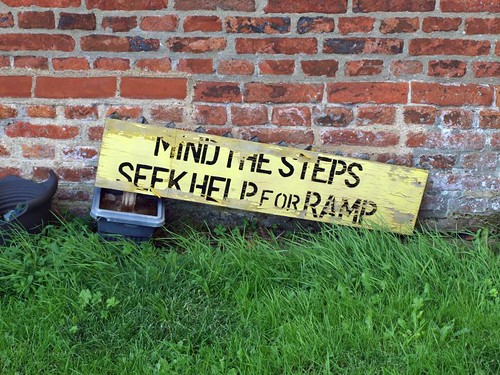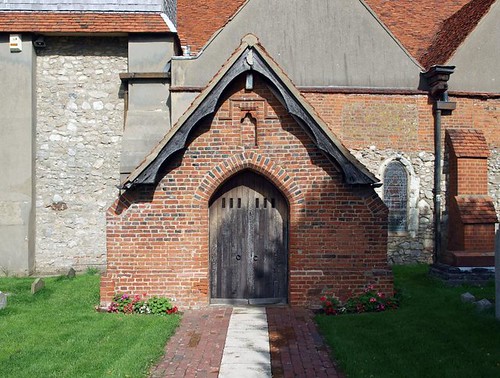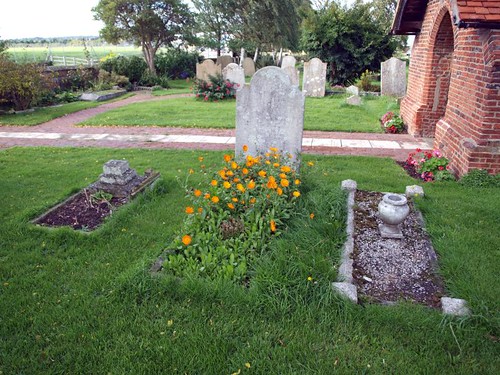Having parked I entered the surprisingly large graveyard from the west and largely ignored the church (it's a really interesting area) but what really strikes you is that to the east - actually literally on the east - is Southend Airport, an EasyJet hub. If Southend ever expands this church is toast.
Having wandered around the graveyard I came to the east end and began to realise that there's more here than initially met the eye but I'll let the boys explain.
As I was leaving a man with a Nikon, and a serious lens, arrived to record aeroplanes which led me to ask myself the existential question - which is sadder plane or church spotting? Luckily my children have answered the question by telling me both are equally sad.
ST LAURENCE AND ALL SAINTS. The Norman church is recognizable only inside. The N wall above the arcade shows three Norman outer windows. The wall below was pierced in the C14 by two broad arches with much wall left standing between. The chancel is C13, as its lancet windows indicate. The W tower, added to the S of the nave, can be ascribed to the same century on the strength of a W lancet. Its upper part is of timber, weather-boarded and ends in a hipped and then needle-thin spire. The S arcade of three bays with octagonal piers and double-chamfered arches may be of c. 1300. The tower arch is of the same design. The exterior of the S aisle is remarkable for its pretty brick porch (early C16) and the two plastered gables on the S aisle wall (C16 or C17?). Timber priest’s chamber in the N aisle. - FONT. Norman, circular, with intersected arches. - DOORS. Its two surviving C13 doors are what the church will be visited for. The earlier one is now inside and unhinged. It is of the early C13 with ironwork in two-and-a-half tiers of large curves and small tendrils between. The other is now the S door, mostly late C13 with a few of the large C-curved early C13 work left. The late C13 added the smaller curves with realistic three-lobed leaves. - PLATE. Cup with band of ornament, and Cover of 1562. - BRASS to Thomas Burrough d. 1600.
EASTWOOD. Here the lover of smith-craft will rejoice, for the ancient ironwork still gives strength to doors which have opened and closed for 20 generations.
Southend is swallowing up Eastwood, but toward the church still linger charming cottages built of wood and roofed with thatch. Rochford-way stands the old workhouse, with an upper storey projecting and a wing built in the days when Joan of Arc was driving our army out of France.
In front of a row of elms a border of grass creeps up to the churchyard wall, and two sycarnores stand before a 16th century porch made beautiful with carved bargeboards on its gable. The roof of the church has a high pitch reaching up beside the wooden tower and covering both nave and aisle in its downward sweep. The tower has stood 700 years, supporting a slender spire, and is itself borne on a stone tower attached for some strange reason to the aisle. The door in the brick porch is one of the most wonderful doors in Essex. For six and a half centuries it has swung on these hinges, the planks held firm by scrolls and flowers hammered out of iron, yet when the smiths fashioned this piece of beauty they used once more the strap-hinges their grandparents had wrought for a still earlier door, with its boldly cut prayer of peace for those who come this way, and those who go. A door inside the church, equally beautiful, has been the companion of this all down the ages, and used to hang in the doorway now blocked up in the opposite aisle.There is notable ironwork on both doors, making them precious possessions for a village.
Close by is a masterpiece in stone, a Norman font with interlacing round arches encircling a tapering bowl. Norman arches older than the font are high up on the walls of the nave, one complete, the others only in part. In this aisle is a curious partition of oak, placed here in the 15th century to give the priest a private room. In the aisle roof is the trapdoor through which the priest used to climb up; it is still on its old hinges.
The chancel has a brass portrait of Thomas Burrough, who died three years before Elizabeth, and the wooden tower has two bells which have called the village to worship for over 500 years.
Southend is swallowing up Eastwood, but toward the church still linger charming cottages built of wood and roofed with thatch. Rochford-way stands the old workhouse, with an upper storey projecting and a wing built in the days when Joan of Arc was driving our army out of France.
In front of a row of elms a border of grass creeps up to the churchyard wall, and two sycarnores stand before a 16th century porch made beautiful with carved bargeboards on its gable. The roof of the church has a high pitch reaching up beside the wooden tower and covering both nave and aisle in its downward sweep. The tower has stood 700 years, supporting a slender spire, and is itself borne on a stone tower attached for some strange reason to the aisle. The door in the brick porch is one of the most wonderful doors in Essex. For six and a half centuries it has swung on these hinges, the planks held firm by scrolls and flowers hammered out of iron, yet when the smiths fashioned this piece of beauty they used once more the strap-hinges their grandparents had wrought for a still earlier door, with its boldly cut prayer of peace for those who come this way, and those who go. A door inside the church, equally beautiful, has been the companion of this all down the ages, and used to hang in the doorway now blocked up in the opposite aisle.There is notable ironwork on both doors, making them precious possessions for a village.
Close by is a masterpiece in stone, a Norman font with interlacing round arches encircling a tapering bowl. Norman arches older than the font are high up on the walls of the nave, one complete, the others only in part. In this aisle is a curious partition of oak, placed here in the 15th century to give the priest a private room. In the aisle roof is the trapdoor through which the priest used to climb up; it is still on its old hinges.
The chancel has a brass portrait of Thomas Burrough, who died three years before Elizabeth, and the wooden tower has two bells which have called the village to worship for over 500 years.
Is it just me or is this a church that cries out to be kept open?



No comments:
Post a Comment